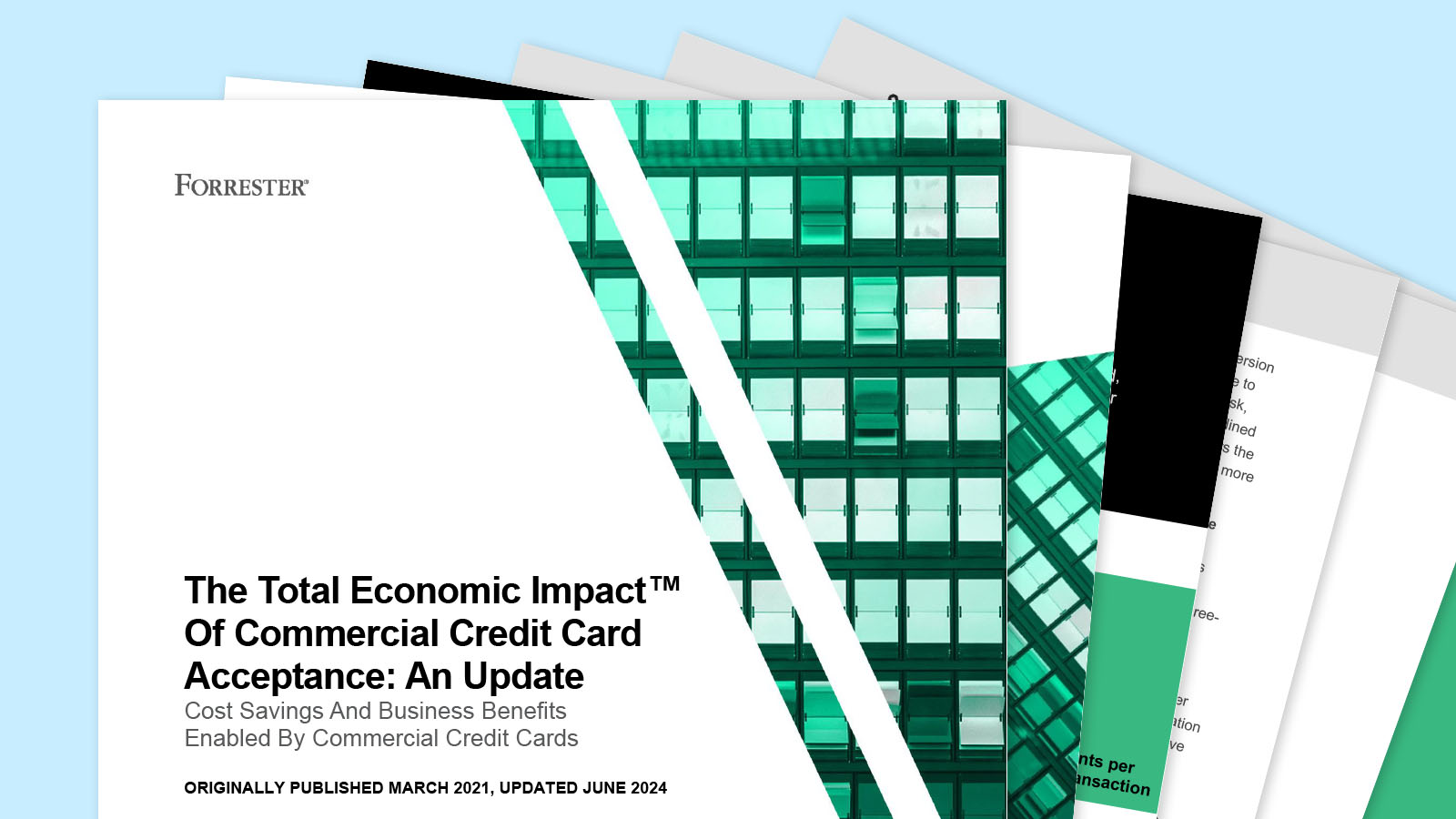

Business-to-business (B2B) payment preferences are continuing to shift as more corporates move away from paper checks and adopt Automated Clearing House (ACH), commercial cards and other digital payment solutions. According to recent analysis by Datos Insights, global commercial credit card spend is expected to reach US$3.57 trillion in 2024 and US$5.07 trillion by 2028.¹
Historically, many businesses have avoided accepting commercial cards for B2B receivable payments because of the persistent belief that the cost of acceptance far outweighed the benefits. However, Forrester Consulting's recent findings from the U.S. market indicate that commercial cards card delivered a net positive economic impact for the participating suppliers.
The difference a few years can make
Visa first commissioned Forrester to conduct a Total Economic Impact (TEI) study in 2021, to examine the potential return on investment (ROI) businesses may realize from commercial card acceptance. Forrester surveyed approximately 160 U.S.-based companies with more than $1B in annual revenues and found that while there were certainly fees associated with accepting commercial card payments, commercial card acceptance was able to deliver a net positive economic impact of 357 basis points (bps) per transaction over alternative ways to pay for a typical* business.²
Since the economy was deep in the COVID-19 pandemic during the first TEI study, Visa asked Forrester to update the analysis in 2024. The result? The case for commercial card acceptance is even stronger today. According to the 2024 study, commercial cards delivered net benefits of 420 bps per transaction, over a 3-year period, for a composite organization representative of interviewed suppliers.³
Buying organizations are increasingly choosing to pay with commercial cards because they are easy to use, secure, offer opportunities to monetize their payments, help increase cash flow and improve working capital management. At the same time, companies accepting cards also reap important benefits.
Impacting the bottom line
One of the most compelling results of the Forrester study revealed that accepting commercial cards was an effective revenue generating tool for interviewed suppliers. The composite organization with a $10B turnover, representative of interviewed suppliers, achieved 24% revenue gains over a three-year period, thanks to card acceptance, by preventing potential business loss to competitors and unlocking additional opportunities from new and existing customers who make larger and more frequent purchases. Adopting commercial cards can have a positive impact on suppliers’ bottom-line.


Cost savings and business benefits enabled by commercial credit cards
An updated study by Forrester Consulting
Reduced DSO, improved debt collection and process efficiencies
Today, interest rates are high, and credit is expensive, making solutions that offer greater working capital benefits more appealing. Commercial cards significantly reduced the Days Sales Outstanding (DSO) and shortened cash conversion cycles for the composite organization—from 45 days to 15 days according to the Forrester study.
Because card acceptance enables immediate collection of past-due payments, surveyed suppliers saw a 20% improvement in debt collection rates.
Similarly, process improvements help suppliers to lower costs. Respondents realized several important process improvements through card-based payment acceptance, including:
- Faster and more cost-efficient new account setup compared to customers paying by ACH or check.
- Time savings through streamlining and automating payment reconciliation process with improved visibility into customers’ payment activity.
- Reduced fraud-related administrative and legal burden, as cards have stronger security measures in place.
Commercial card adoption makes good business sense
Comparing the costs and benefits of commercial cards to traditional payment methods, one thing becomes abundantly clear: cards make a lot of sense. Commercial cards can facilitate both revenue protection and growth opportunities, while also helping to improve receivables collections, delivering process and DSO.
While a one-dimensional view of the economics, focused solely on fees, means some businesses have had limited card acceptance, the Forrester study demonstrates that the value unlocked through card acceptance can significantly outweigh the costs. Businesses that previously limited card acceptance would be well-served to re-evaluate their payment acceptance strategy.
*For the purposes of the study and financial modelling, Forrester aggregated the experiences of the interviewees and survey respondents and combined the results into a single composite organisation that earns $5 billion in annual revenue and has an average transaction value of $5,000.
- Key Trends in Corporate Commercial Cards: A Global View. Datos Insights, September 2024.
- The Total Economic Impact™ of Commercial Credit Card Acceptance, a commissioned study conducted by Forrester Consulting on behalf of Visa, March 2021.
- The Total Economic Impact™ of Commercial Credit Card Acceptance, a commissioned study conducted by Forrester Consulting on behalf of Visa, March 2021, updated June 2024.
Study Methodology
The purpose of the study by Forrester Consulting is to provide readers with a framework to evaluate the potential financial impact of commercial credit cards on their organizations. All references to “credit cards” in this study refer to commercial or virtual cards for B2B transactions.
To better understand the benefits, costs, and risks associated with this investment, Forrester interviewed nine decision-makers from seven organizations with experience accepting commercial credit cards and conducted a double-blind survey of 153 additional decision-makers from such organizations. For the purposes of this study, Forrester aggregated the interviewees’ experiences and combined the results into a single composite organization that generates $10 billion in revenue and has an average transaction value of $10,000.
Prior to accepting commercial credit cards for B2B transactions, interviewees' organizations accepted traditional payment methods — predominantly Automated Clearing House (ACH) payments and checks. These payment methods failed to meet customer demands for convenient payments and created various process-related and business challenges. Adopting commercial credit cards addressed pain points while also aligning merchants with customer preferences. Through the investment, the interviewees’ organizations realized incremental gross revenue gains, reduced fraud, faster debt collection, reduced daily sales outstanding (DSO), and streamlined payment-related processes.